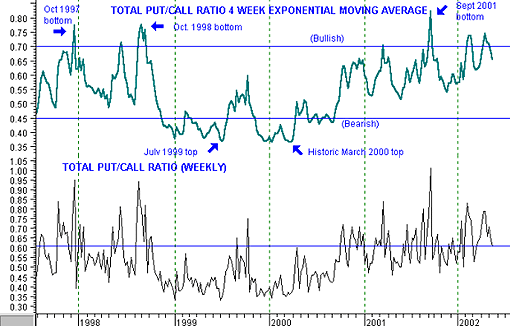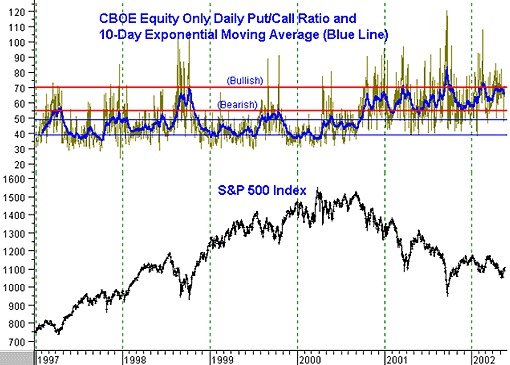CBOE Data
Betting Against the "Crowd"
It is widely known that options traders, especially option buyers, are not the most successful traders. On balance, option buyers lose about 90% of the time. Although there are certainly some traders who do well, would it not make sense to trade against the positions of options traders since most of them have such a bleak record? The contrarian sentiment put/call ratio demonstrates that it does pay to go against the options-trading crowd. After all, the options crowd is usually wrong.
Looking inside the market can give us clues about its future direction. Put/call ratios provide us with an excellent window into what investors are doing. When speculation in calls gets too excessive, the put/call ratio will be low. When investors are bearish and speculation in puts gets excessive, the put/call ratio will be high.
The equity put/call ratio on this particular day was 0.64; the index options put/call ratio was 1.19; and the total options put/call ratio was 0.72. As you will see below, we need to know past values of these ratios in order to determine our sentiment extremes. We will also smooth the data into moving averages for easy interpretation.
Chicago Board Options Exchange (CBOE) Options Volume
|
Total Weekly Put/Call Ratio Historical Series
There are different ways to construct a put/call ratio, but the traditional CBOE total weekly put/call ratio is a good starting point. By total, we mean the weekly total of the volumes of puts and calls of equity and index options. We simply take all the puts traded for the previous week and divide by the weekly total of calls traded. This is the weekly total put/call ratio. When the ratio of put-to-call volume gets too high (meaning more puts traded relative to calls) the market is ready for a reversal to the upside and has typically been in a bearish decline. And when the ratio gets too low (meaning more calls traded relative to puts), the market is ready for a reversal to the downside (as was the case in early 2000). Figure 2, where we can see the extremes over the past five years, shows this measure on a weekly basis, including its smoothed four-week exponential moving average.
 Figure 2 -- Created using Metastock Professional. Data Source: Pinnacle IDX |
Figure 2 reveals that the ratio's four-week exponential moving average (top plot) gave excellent warning signals when market reversals were nearby. While never exact and often a bit early, the levels should nevertheless be a signal of a change in the market's intermediate term trend. It is always good to get a price confirmation before concluding that a market bottom or top has been registered.
These threshold levels have remained relatively range-bound over the past 20 years, as can be seen from figure 2, but there is some noticeable drifting (trend) to the series, first downward during mid-1990s bull market and then upward beginning with the 2000 bear market.
 Figure 3 -- Created using Metastock Professional. Date Source: Pinnacle IDX |
Despite the trend, the smoothed put/call ratio is still useful; however, it is always best to use the previous 52-week highs and lows of the series as critical thresholds. My experience has been that put/call ratios are best used in combination with other sentiment indicators and perhaps a price-based (i.e., momentum) indicator. More elaborate mathematical massaging of the data (i.e., de-trending by differencing the series) can also help.
Equity-Only Daily Put/Call Ratio
Since it includes index options, which are used by professional money managers to hedge portfolios of stocks, the total put/call ratio can distort the measurement of the temperature of our purely speculative crowd. Arguably, a better gauge is the CBOE's equity-only put/call ratio. Figure 4 contains the CBOE raw daily put/call ratio and its 10-day exponential moving average - both are plotted above the S&P 500 stock index. As the bear market has shifted the average ratio to a higher range, the horizontal red lines are the new sentiment extremes. The past range, indicated by the horizontal blue lines, had threshold values of 0.39 to 0.49. The new threshold values are 0.55 and 0.70. Currently, the levels have just retreated from excessive bearishness and are thus moderately bullish.
 Figure 4 - Created using Metastock Professional. Source: CBOE Market Statistics |
Conclusion
Historically index options have a skew toward more put buying. This is because of the index put option hedging done by portfolio managers - this is also why the total put/call ratio is not the ideal ratio (it is polluted by this hedging volume). Recall that the idea of contrarian sentiment analysis is to measure the pulse of the speculative option crowd, who, on balance, is wrong. We should therefore be looking at the equity-only ratio for a purer measure of the speculative trader. In addition, the critical threshold levels should be dynamic, chosen from the previous 52-week highs and lows of the series, adjusting for trends in the data.
As with any indicators, they work best when you get to know them and track them yourself. While I don't like to use them for mechanical trading signals, put/call ratios do outline, quite reliably, zones of oversold and overbought market conditions. They should thus be included in any market technician's analytical toolbox.